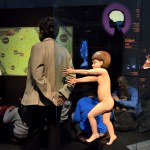EXTRA, the marketplace for scientific touring exhibitions.
The brain is undoubtedly one of man’s final “uncharted territories”. If last century was given over to exploring the most inaccessible places on our planet, the tiniest particles of matter, and even across our solar system, the issues at the start of this century can be found in our cranium. For a long time seen as a secondary organ, the brain continues to slowly disclose its secrets with advances in research and imaging techniques.
Today neuroscience is central to people’s interests and preoccupations. The exhibition hopes to make visitors of all ages aware of the numerous questions raised by this theme, whilst placing it at the heart of research in a socially aware manner.
With the aid of current scientific elements, the visitor is encouraged to explore his brain by means of an exhibition which is presented in the form of a huge discovery and testing ground.
In a cross-disciplinary manner, he can explore neurone networks, find out how the brain can evolve and change at any age, compare his brain to that of other brains in the animal kingdom, understand artificial intelligence, test his cognitive functions and finally see how unique his brain actually is.
Part A - Who's got a brain?
Who’s got a brain or something similar over the course of evolution? When did the first brain develop? Interactive videos and models enable visitors to understand the difficulty of dating the first appearanceof this organ.
An interactive map representing the phylogenetic tree of brains takes the visitor on a journey through evolution and the variability of nerve centres over time.
This space is arranged like a “bestiary” of brains portraying animals and their nervous systems.
Part B - 1 000s brains - 1 000 worlds
Every brain has its own world…
Each and every animal species lives in a world of its own. This subjectivity is dependent on the organisation of nervous, sensorial and effector systems, the way in which they learn to use these systems, and finally the environment. This part showcases four “worlds”, each bringing together a collection of animals with the same degree of brain capacity: “a world of reflex”, “a world of programmes”, “a world of innovation” and “a world of culture”.
This journey into the animal world is made possible by means of videos, multimedia and interactive games.
Part C - How to play tricks on your brain
In this maze, the senses are tricked, the brain is manipulated and reality appears to be distorted. onfronted with these illusions the visitor understands from the experience that the brain interprets the information that is picked up by our senses. These interpretations are sometimes erroneous due to the fact that the brain is trying so hard to find a meaning where there isn’t one.
The maze is a journey interspersed with illusions of all kinds and places emphasis on the physiological reasons which explain why our brain places different interpretations on what it perceives.
Part D - A cybernetic world
Is it possible to create a robot endowed with intelligence and awareness? Will we one day be able to control a bionic arm with our brain? How does a robot see the world?
This part presents the state of research in the light of the latest advances in robotics and neuroscience. The public finds out about the latest technologies enabling a human to command and communicate with a machine and also sees how robots are capable of learning and communicating.
Part E - A world of plasticity
Does the brain evolve throughout the course of our life? What revolutionary discoveries has neuroscience made to once again shelve the ancient theories which claim that everything was already in place before you reached 20 years of age? What is cerebral plasticity? What role does it play in the learning process? How does the brain adapt to the events which shape our lives?
Videos and digital interfaces showcase scientific advances on this incredible field of of cerebral plasticity.
Part F - Zooming in on the brain
This part sees the visitor enter the most mysterious organ of the human body.
Here we discover the brain from every angle and its basic element, the neuron. Our brain has more than 100 billion of them, each of which communicates with 10,000 neighbours.
This incredibly complex network can today be observed “in situ” thanks to medical imaging.
This space gives visitors the chance to find out about their brain from every perspective. A ‘Cervomaton’ (a photo booth for the brain) enables the visitors to observe the general anatomy of their brain in 3D, the “Spread the word” pinball machine is a game to help you understand the workings of a neuronal network and the law of “all or nothing”, multimedia gives the visitor a chance to play at tracing the transfer of information at the heart of the synapse, all in a world that has been recreated by the magic of medical imaging.
Part G - The Cognitilab
This is the central element of the exhibition. This laboratory, with its great immersive power, places the visitor at the heart of the exhibition. It is a dome (optional) in which eight testing stations are equipped with eight tactile tablets. The visitor makes himself comfortable, selects the cognitive function of his choice and does the relevant test. Once the test is over multimedia helps him makes sense of this cognitive function.
The two cognitive functions which are tested are memory and attention.












